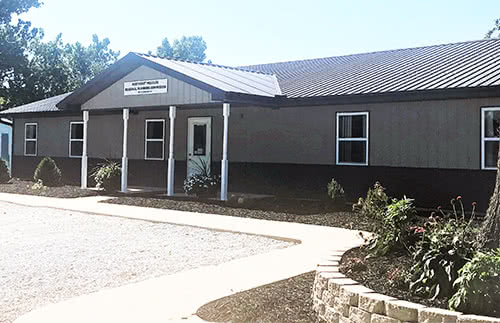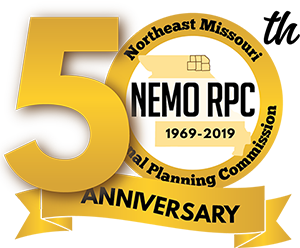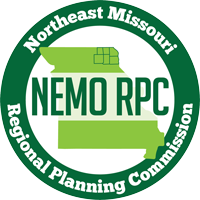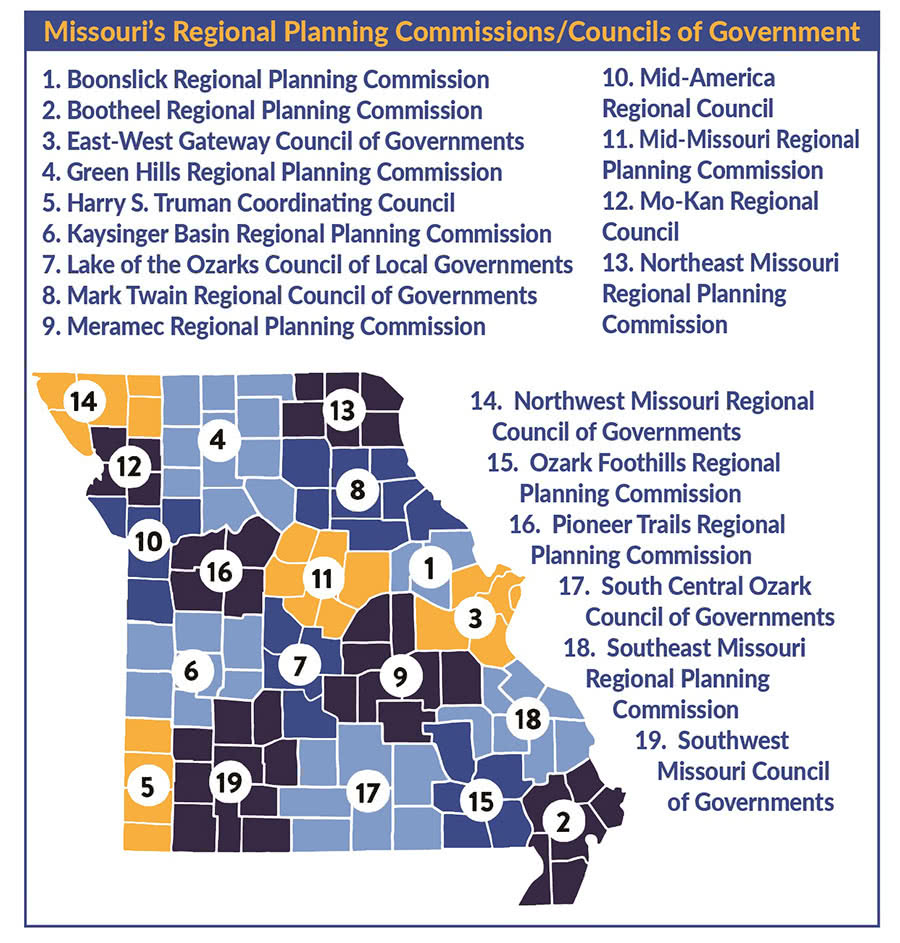History of Northeast Missouri Regional Planning Commission
The Northeast Missouri Regional Planning Commission (NEMO RPC) was created by the State of Missouri and Governor Warren E. Hearnes on the 19th day of March in 1969. NEMO RPC was formed to coincide with the boundaries of the counties of Adair, Clark, Knox, Schuyler, and Scotland. The original region served the five counties and 27 incorporated cities for a total of 32-member governments. In 1992, Lewis County petitioned the State of Missouri and the NEMO RPC membership to join the region and later that year was assigned by the state to the boundaries of the Northeast Missouri Regional Planning Commission/ Rural Development Corporation and Economic Development District.
Nearly a decade later, on August 16, 1978, the Northeast Missouri Regional Planning Commission incorporated as the Northeast Rural Development Corporation (NEMO RDC) to expand the mission and objectives for the region in Northeast Missouri. The Corporation was established as a not-for-profit 501(c) 3 with the same by-laws as the Regional Planning Commission and the Commission and Corporation would be one and the same. Three years earlier, in December 1975, the NEMO RPC had entered into a cooperative agreement with the Counties of Adair, Clark, Knox, Schuyler, and Scotland to formulate the Public Housing Agency (PHA) for the member counties, becoming the administrative agency for the newly formed Scotland County Public Housing Agency.
NEMO RPC continually looks to expand working to help make every community priority in Northeast Missouri achievable. NEMO RPC partners with many state and federal agencies to deliver much-needed funding in the form of grants for all of Northeast Missouri. Northeast Missouri Regional Planning Commission will continue to strive to bring added value to all of its members.


Missouri Association of Councils of Government (MACOG)
Northeast Missouri Regional Planning Commission is a member of the Missouri Association of Councils of Government (MACOG). MACOG is the statewide organization representing Missouri’s 19 regional planning commissions and councils of government. These professional organizations represent the entire State of Missouri and are committed to enhancing the state’s regions. Regional councils are engaged in a myriad of activities, including:
-
Economic and community development
-
Housing initiatives
-
Safety and security
-
Transportation planning
-
Environmental issues
-
Quality-of-life issues
These activities create jobs for Missourians, stimulate private investment and attract millions of dollars which support public projects. MACOG’s organizations serve the state’s 114 counties and more than 6.8 million people.
Regional Planning Commissions
Organization Overview
Regional planning commissions across the United States, and in Missouri as well, are known by a variety of names, including councils of government, regional planning commissions, areawide planning organizations, economic development districts, and area development districts. Regardless of their name, there are several basic and fundamental similarities among the organizations. All have been formed by the local government in one manner or another. All must have operating budgets in order to be able to function. All must have staff in order to provide for the work that is directed to them by their member governments, collectively or individually, and by various state and federal agencies with which the agency contracts under the authority of the board of directors and their membership. In Missouri, regional planning commissions are advisory in nature, and county and municipal governments hold membership on a voluntary basis.
Issues Addressed
Typically, regional planning commissions address a broad cross-section of issues, including comprehensive planning; economic development, including marketing, industrial park development, operation of revolving loan funds, and coordination with industrial prospects and various agencies and organizations involved in economic development. Most regional planning commissions deal with infrastructural issues, such as public water supply; sanitary sewage collection and treatment; planning for various modes of transportation, including local streets and roads, highways, airports, port development, as appropriate, mass transit, and in some instances, rail. Regional planning commissions are also, from time to time, involved in park, recreational and open space planning and issues; development of various ordinances, such as subdivision regulations, zoning ordinances, mobile home park ordinances and the like; coordination of programs on behalf of county and municipal members with state and federal agencies; solid waste planning; hazardous waste planning; stormwater damage and flood control, including the National Flood Insurance Program; working for Improved educational and training facilities; manpower planning and job training issues; health and health facilities needs; and planning for compatible land usage. Most regional planning commissions also prepare grant applications for implementation of various capital improvements and initiation of various programs. Numerous regional planning commissions also assist county and municipal governments in administration of grants-in-aid. Some regional planning commissions are also involved in agricultural issues, housing development, and provision of a variety of direct services under an agreed upon basis with member units of government. A number of regional councils provide mapping and drafting services for their memberships.
Primary Role
The role of the regional planning commission or council of government varies in each region, depending upon the desires of the member counties and municipalities and their representatives. Nonetheless, the prime role of the regional planning commission is to provide a technical staff capable of providing sound advice to its membership and to work for the coordination of various planning and infrastructural needs among the various counties and municipalities, as appropriate. Many regional planning commissions/councils of government conduct a considerable amount of research as a matter of course in their day-to-day operations and often have a considerable amount of data and information available for use by their members and citizens of the region. A number of the regional planning commissions in Missouri serve as repositories for census data under an agreement with the Missouri State Library and its Data Affiliate Program. Most of the regional planning commissions have a small technical and planning library which also houses a wealth of data and information about their respective regions and, perhaps, a broader area.
Not-For-Profit
Most of the rural regional planning commissions in Missouri were formed under Chapter 251 of the Revised Statutes of the State of Missouri. Some are incorporated separately as not-for-profit corporations, and yet others, particularly in the metropolitan areas, were formed by interstate compact or other incorporating methods. Several of the regional planning commissions, notably East-West Gateway Coordination Council, Mid-America Regional Council and Mo-Kan Regional Council, serve as bi-state regional planning groups for their respective areas. All regional councils in Missouri operate on a not-for-profit basis.
Assistance for Communities
The regional planning commissions across the State of Missouri provide an effective way for local governments to work together to address common problems and to share technical staff for problems that cross border lines or boundaries and need an areawide approach. They also can effectively deliver programs that cannot be afforded on an individualized basis by county and municipal governments but can be afforded on a collective basis where all share staff and/or resources. The intent of the regional planning commissions in Missouri is to be of service to their member counties and municipalities and to bring an organized approach to addressing a broad cross-section of areawide problems. They also are available to assist their member entities in coordinating the needs of the area with state and federal agencies or with private companies or other public bodies.


